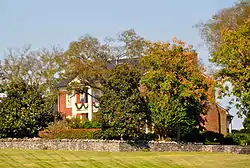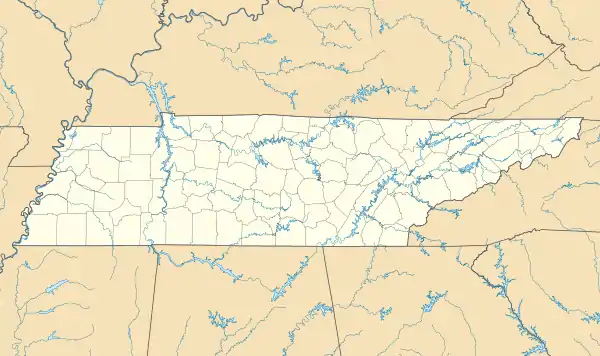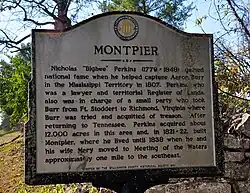Montpier | |
 Montpier, October 2014. | |
  | |
| Location | Off Hillsboro Pike, northwest of Franklin, Tennessee |
|---|---|
| Coordinates | 35°58′59″N 86°56′1″W / 35.98306°N 86.93361°W |
| Area | 2 acres (0.81 ha) |
| Built | 1821 |
| Architect | Perkins, Nicholas |
| Architectural style | Federal, Greek Revival |
| NRHP reference No. | 82004073[1] |
| Added to NRHP | August 26, 1982 |
Montpier, also known as Nicholas Perkins House, is a two-and-a-half-story brick house built on a stone foundation during 1821–22. It has a gable roof with twin brick chimneys at each gable end. It was built with slave labor. Its original style was Federal, but its facade was modified in the 1859s by addition of a Greek Revival two-tiered portico and a doorway with side lights, corner lights and transom.[2]

The Williamson County Historical Marker for Montpier.
It was built for Nicholas "Bigbee" Perkins III (1779-1848), of a plantation family. Perkins is notable as the man who recognized Aaron Burr and assisted in Burr's arrest for treason on February 18, 1807.[2][3]
The house was listed on the National Register of Historic Places in 1982.[1]
References
- 1 2 "National Register Information System". National Register of Historic Places. National Park Service. March 13, 2009.
- 1 2 "National Register of Historic Places Inventory/Nomination: Nicholas Perkins House / Montpier". National Park Service. with 10 photos from 1982
- ↑ "Nicholas Perkins III". Encyclopedia of Alabama. Retrieved 2023-06-08.
This article is issued from Wikipedia. The text is licensed under Creative Commons - Attribution - Sharealike. Additional terms may apply for the media files.